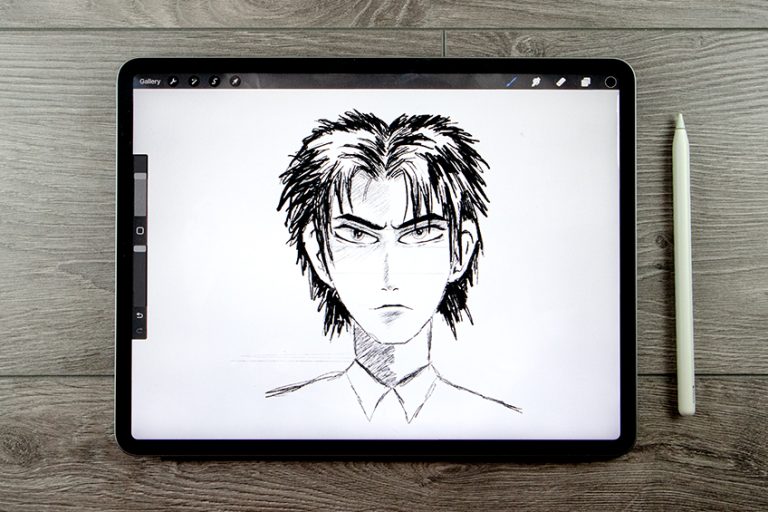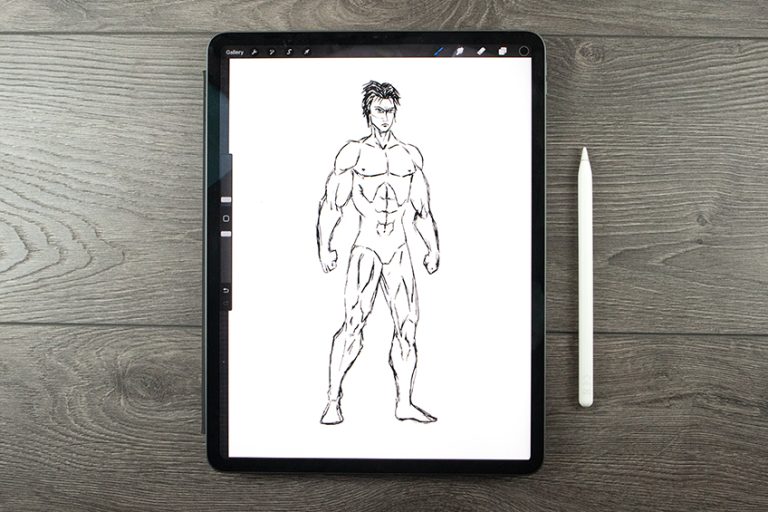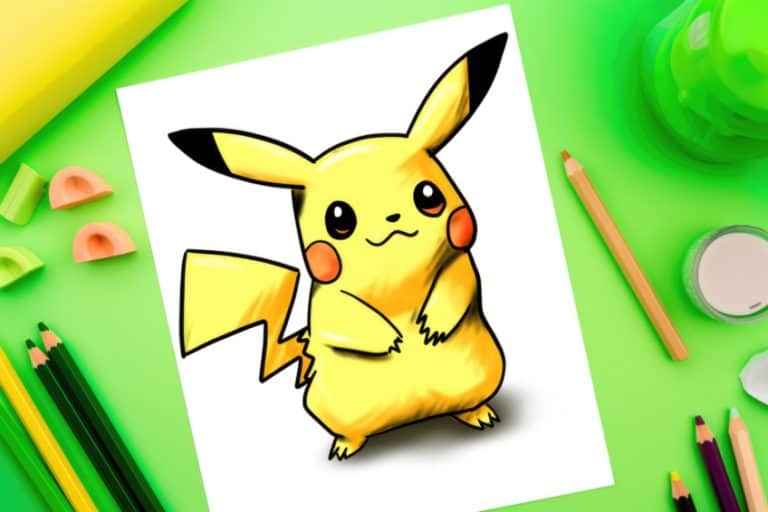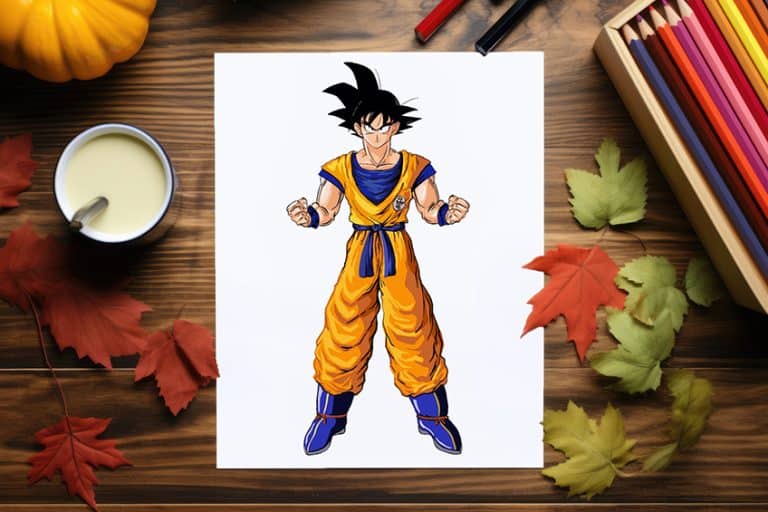How to Draw Anime Faces and Heads – An Easy Guide
Anime faces have a unique aesthetic within their various features, which distinguishes them from other Western animated characters. There are also various styles and ways to learn how to draw anime heads. In this tutorial, we will explore anime face drawing and will break down some unique ways we can define the anime features. The process of developing anime faces is quite similar between both anime boy and anime girl faces. There are subtle differences that can often distinguish between the androgynous quality within the anime character style. Understanding the fundamentals of anime face drawings will provide you with a lot of freedom to create variations within your anime faces and heads.
Table of Contents
- 1 An Easy Guide to Anime Face Drawing
- 2 Step-by-Step Guide on How to Draw Anime Faces
- 3 Utilizing Color for Anime Character Design
- 4 Tips and Tricks to Remember
- 5 Frequently Asked Questions
An Easy Guide to Anime Face Drawing
In this tutorial, we will break down the fundamentals of creating interesting anime face drawings. As we learn how to draw anime faces, we will look at how to create variation within anime girl faces as well as anime boy faces. This tutorial will demonstrate the process through a few simple steps, providing us with the toolkit for creating beautiful anime girl head and boy head drawings.

This tutorial on how to draw anime faces is done with a digital device, however, all drawing processes can be followed with traditional drawing materials. You can use whatever materials you have available as we will be covering the basics of anime base head formations and details in the face.
Step-by-Step Guide on How to Draw Anime Faces
In this tutorial on how to draw anime faces, we will be looking at how to formulate various styles and shapes of anime base heads and faces. This will help us gain an understanding of the construction method used to form an anime girl face and anime girl head in various ways, as well as male faces and head shapes. We will utilize some simple rules from the Loomis method to establish the placement of different features, and then look at how to give them unique anime-like qualities in the context of their unique head shapes.
Drawing a Female Character in a Simple Cartoon Style
We are going to start by drawing an anime girl’s head in a very specific style utilizing some guidelines from the loomis method to help us with the placement of the different facial features. Anime can shift from more cartoon-like features to more realistic features.
Let’s start simple with some basic cartoon-like features in our first anime base head drawing.
Step 1: Forming the Head
We want to start by understanding the basic formation process of anime-based head structure. There are many ways to do this, in this case, we will be using the Loomis method to establish the various features. You can find more information on the Loomis method through the link: insert link

Step 2: Drawing the Facial Features
As we continue, we will first draw a female character, starting with the eye. Eyes can be drawn in many ways and depending on the shape convey different expressions. In this case, we can make a shocked expression by a circular eye shape.

We can use the concept of basic shapes to help us understand how to shape different features in the face. In this case, we can have circular shapes to determine a unique shocked expression.

We can also keep the nose petite, as well as work a hairstyle around the structure of the head. The eyelashes can also be elongated to give a more feminine quality and the hair can be styled according to the perspective from which the character is seen.
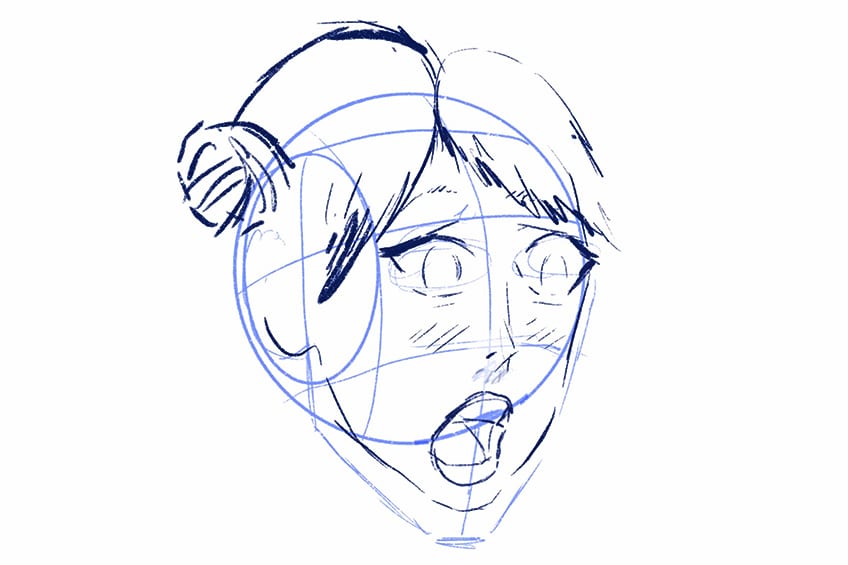
Step 3: Refining the Details and Features
We can now start to incorporate some shading to our character, as well as bring more shape to the various details. There are many ways to create more feminine qualities, such as a petite nose, and elongating the lashes and the hairstyle.
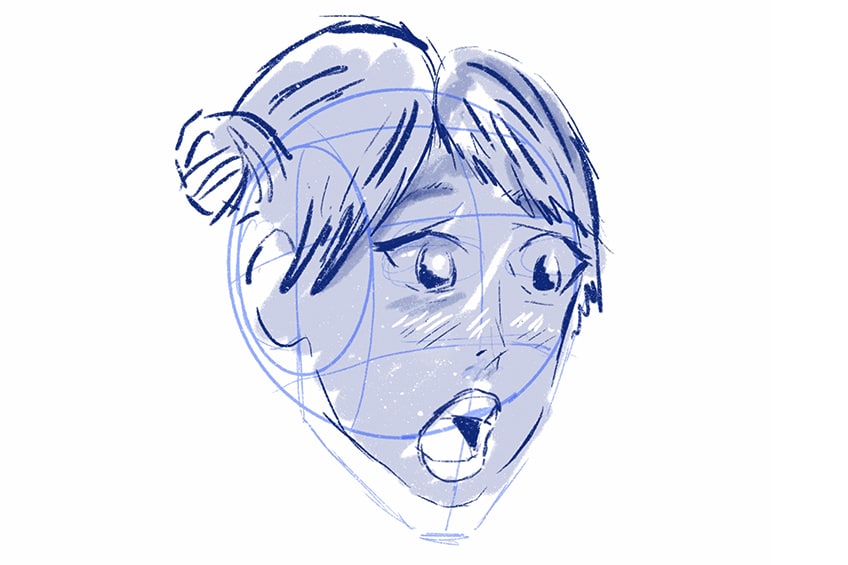
With anime characters, they are often androgynous, so all the features collectively create a unique feminine or masculine quality within the character. Naturally, we can keep these details or simple to create different anime styles
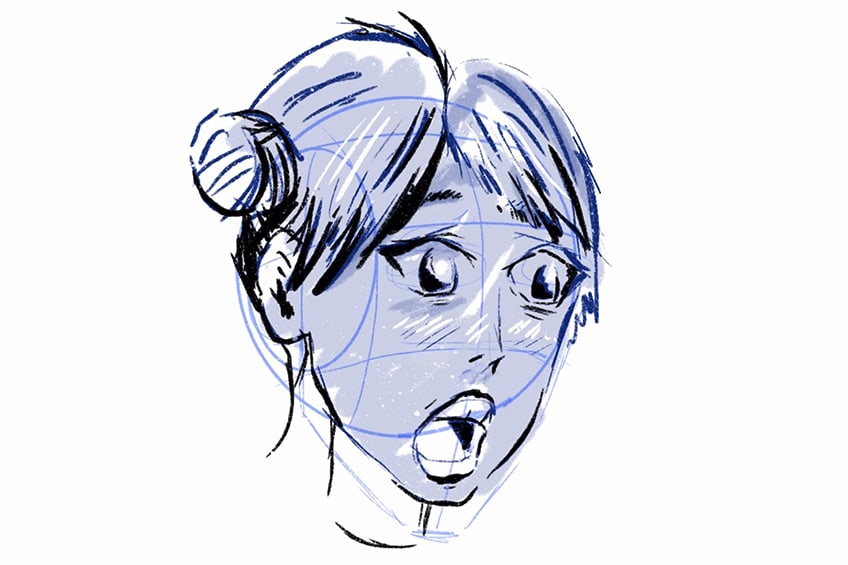
Drawing a Female Character With More Detail
There are many ways to learn how to draw anime girl faces, and now that we understand the basic formation process, let’s take a look at another character in a completely different style.
This time, the character will have different details and unique attributes that change the style of the overall anime aesthetic.
Step 1: Forming the Head
Once again, the Loomis method is effective in helping us establish a unique perspective for various anime faces and heads. In this case, we form the head from an above perspective utilizing these grid lines.

We can then start to establish the placement of the various features in their most basic shapes. Again, thinking about more feminine qualities in each feature is essential.

With anime girl faces, the features are often quite meek to suggest innocence. However, sometimes we can play around with unique combinations between expressions to create more nuanced expressions.

Step 2: Drawing the Facial Features and Refining the Details and Features
In this case, we can utilize the circular shape to suggest a feminine eye quality. However, to maintain neutrality in the expression, we can also make the eye shape more oval, suggesting that the eyes are less innocent or childlike. We can also add more volume to the lips with shading, creating an older more voluptuous quality in the face. The eyebrows can also remain quite neutral in shape, making the character seem more discerning.
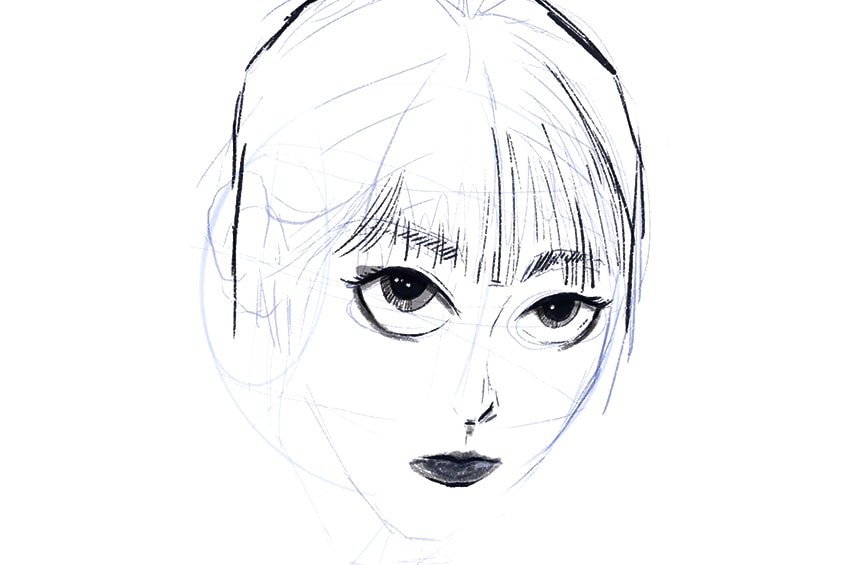
The hairstyle also plays a large role in establishing the maturity within the character, which can give more adolescent or adult-like qualities. This is where we want to consider the combination of feature styles and how they create a unique aesthetic.
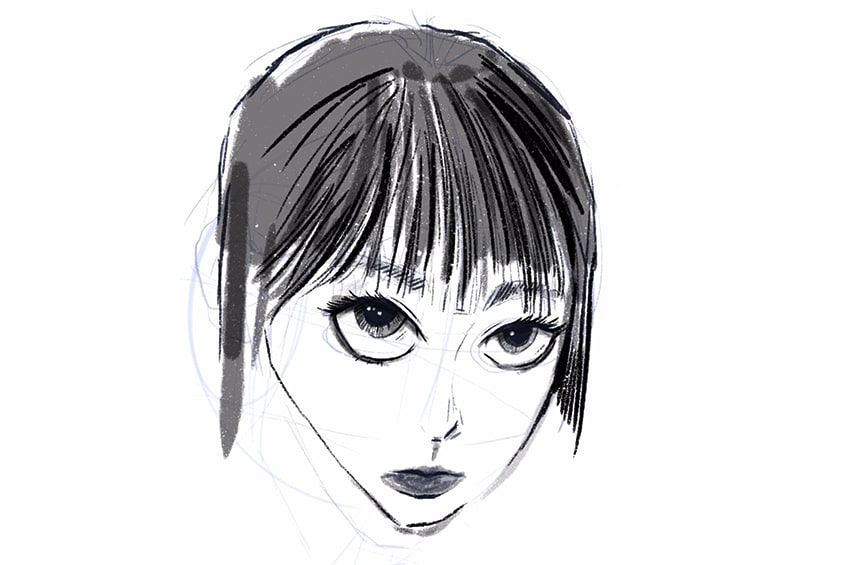
Drawing a Male Character With a Simple Style
From various genres of manga to more modern styles of anime, there are many ways to define a character with a simple set of features.
In some cases, it is also about the use of linework and how that implies the style.
Step 1: Forming the Head
Once again, we choose the angle at which we are drawing the character, and in this case, we can draw a character from a side view. The idea is to think about the personality of the character when forming the head structure.
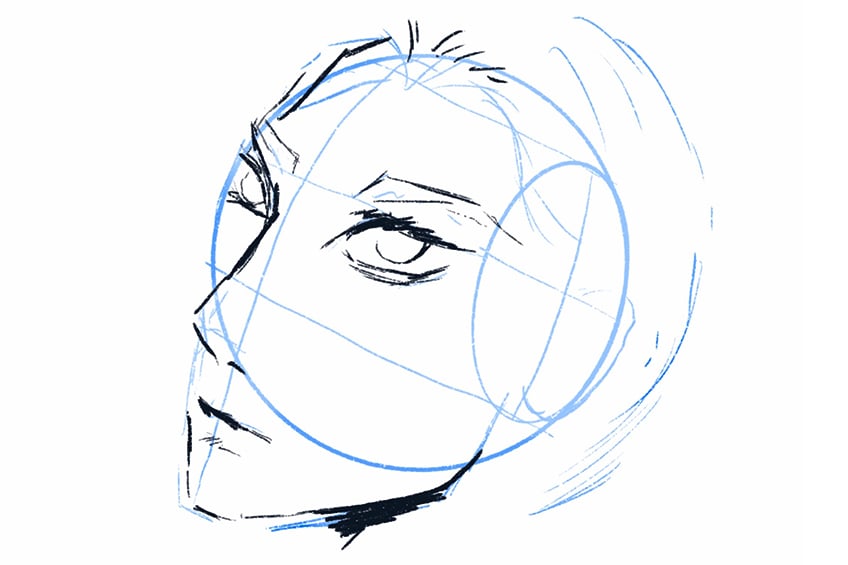
Step 2: Drawing the Facial Features
With male characters, we can keep the eyes quite neutral in their shape, something more square or rectangular. We can also make the nose ridge slightly larger and the mouth quite linear and simplified.

Step 3: Refining the Facial Features
We can also play around with the hairstyle, naturally, the hairstyle will have a large effect on the overall aesthetic. We can also consider the shape of the jaw and how we might change it to be more masculine.

With masculine characters, the jaw shape is generally more large and square. However, we can make a character seem younger by defining a slightly more triangular shape in the face. This is a more basic approach to a male character.
Drawing a Mature Female Character
Utilizing some of the tips and tricks we have learned, we can now apply these to a new character design. Anime characters tend to be quite androgynous.
The overlap between masculine and feminine details can be used strategically to represent more mature anime characters.
Step 1: Forming the Head
Let’s draw a character by utilizing the grid system of the Loomis drawing method again. We want to establish the grid for a more correct positioning to create a realistic shape in the different features.
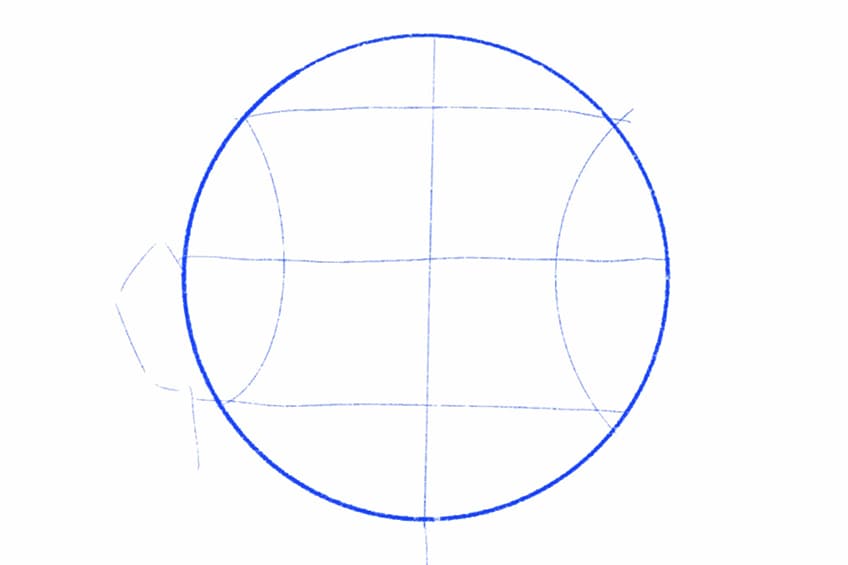
In this case, let’s work with. more square-like shape to the eyes, creating more neutrality in them. We can keep the nose petite, to give it a more feminine quality, and the mouth can be large as well to suggest a more feminine quality.
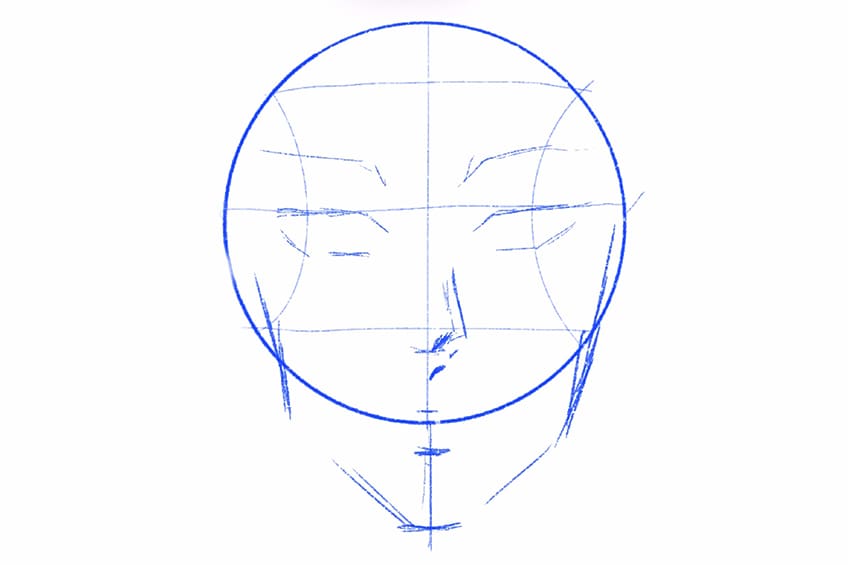
We can also consider the shape of the hairstyle and how it defines the shape of the face. Again, hairstyles are always a major contextualizing feature of the overall appearance of the character.
Step 2: Drawing the Facial Features
We can now start to draw in the facial features, working with some elongated lines in the lashes to create a more feminine shape. Again, the eyes may be neutral, but the elongation of the lashes makes them more feminine, resulting in a mature look.

The nose can remain more simplified with slightly more elongation in the ridge. The mouth can be quite large, with some shading to suggest volume in its shape.
Step 3: Refining the Facial Features
We can refine the facial features by adding some highlights to the eyes to suggest a reflection on the glossy surface. We can also add some shading along the face to provide more dimension.

Slowly, we can work in more tonal values to the anime face drawing, creating more structure along the facial features and hair. When learning how to draw anime girl faces, we find that the combination of features can create age variations.

Drawing a Mature Male Character
Most often male characters tend to be quite androgynous, however, in some manga, we can find a lot of masculine characters that are distinctly male. This is by the utilization of all the right masculine feature combinations.
Let’s take a look at how we can create a male anime character in a few simple steps.
Step 1: Forming the Head
Once again, the intention is to form the head from an angle that is interesting or unique, in this case, we will form a character from the side angle.

Step 2: Drawing the Facial Features
In this case, we can be more direct with the masculine aspects, such as a square jaw, strong nose, thicker eyebrows, and narrow eyes. This will create quite a strong aesthetic in the facial quality of the male character.

The intention is to always play around and consider how different features pair in unique ways to have unique results in the anime character.
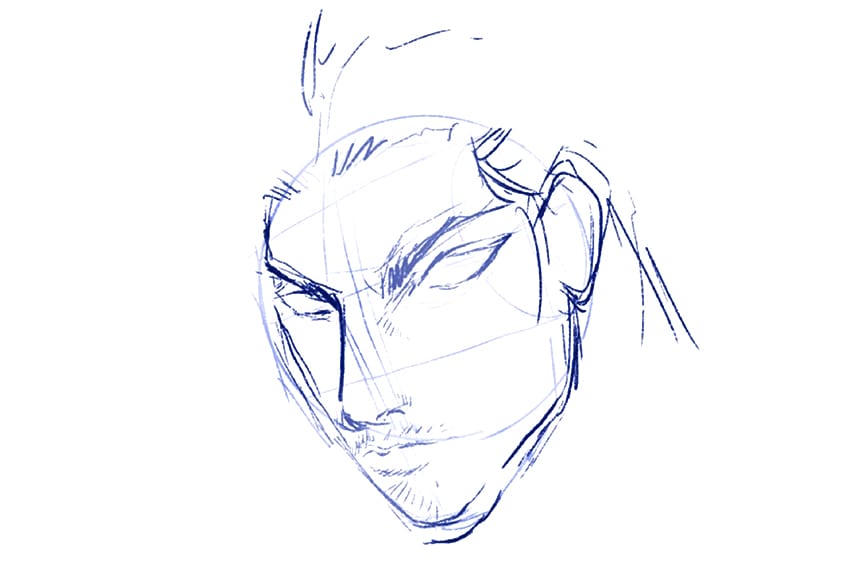
Step 3: Refining the Facial Features
Once we have the general features, we can then start refining them with details and linework. Again, the tools you use and the types of lines will have an aesthetic effect on the character as well. We want to always consider all aspects of the character, this means the features and how they are represented through the use of unique details and linework.

Slowly, we will see how the character unfolds through the combination of unique shapes and lines within the various features.

As we start to bring more shape to the different features, the character becomes more refined and distinct in its unique style.

We can then proceed by incorporating some shading to bring more tonal variation and dimension to the character. This is where we think about thicker darker lines for hair and softer shading along the facial features.
Drawing a Realistic Female Character
Let’s take a look at one last character, where we consider a unique position and pose in the head shape. We will also look at how linework and shading can be used strategically to give a more realistic quality to the character design.
You will also see the more realistic side of anime drawing here.
Step 1: Forming the Head
Once again, the Loomis method can be used to shape different poses within the head. This is helpful for the placement and scaler of various features and how they form along the surface area of the head.

Using the grid lines, we can work from the main circular shape and start developing the rest of the facial features from that shape. This is where we can consider a slimmer face for a feminine character.
Step 2: Drawing the Facial Features
Using the grid lines, we can apply the various facial features accordingly, thinking about the shape and scale at this point.
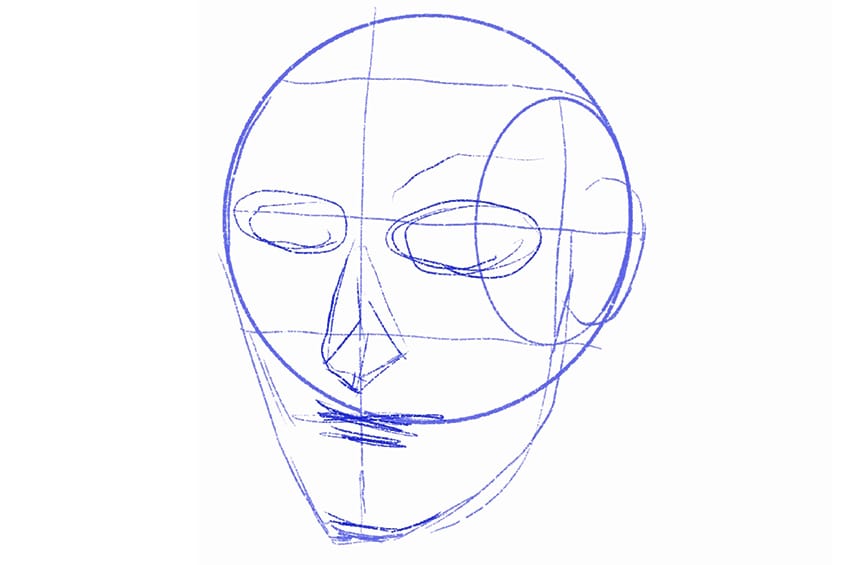
Once again, we can consider our preferred combination of shapes for the various features. We can also start to establish the structure of the hair and how it will form along. the head. Taking our time we can think about the personality of the character and how the features will affect their aesthetic. With female characters, we can always make the lips slightly more defined to suggest volume in their shape. The idea is to always consider the combination of the features in conjunction with one another.
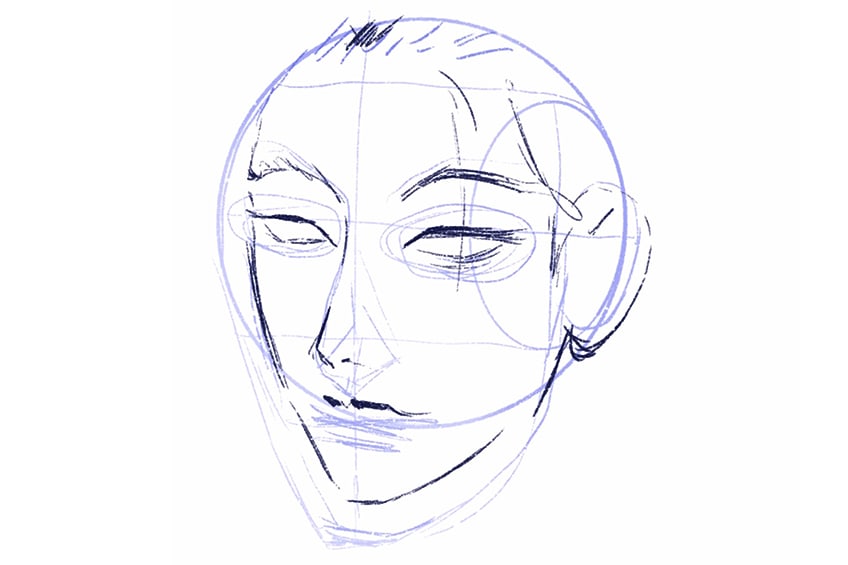
For more neutral expressions, rectangular eyes will always suggest a more discerning quality in the face. Another major factor is the hairstyle, which helps to both shape the head and define the maturity of the character.
Step 3: Refining the Facial Features
From here, we can begin to think about shading and linework as a way of refining these features to create a more distinct shape.
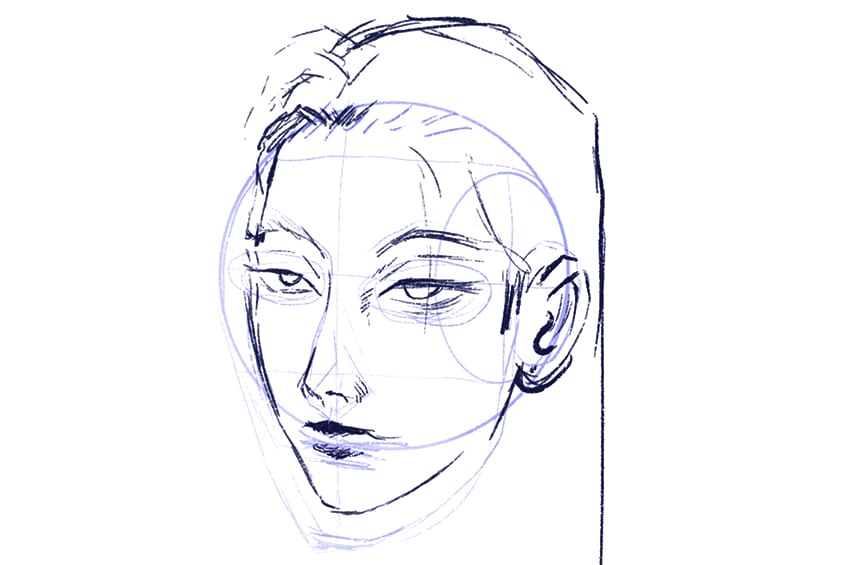
This is where we can refine the shape of the facial features, giving more length to the eyelashes and refining the shape of the face more distinctly. We can also add some volume to the lips with some shading to suggest volume.

The use of highlights is also an effective way of creating tonal variation within the face of the anime character.
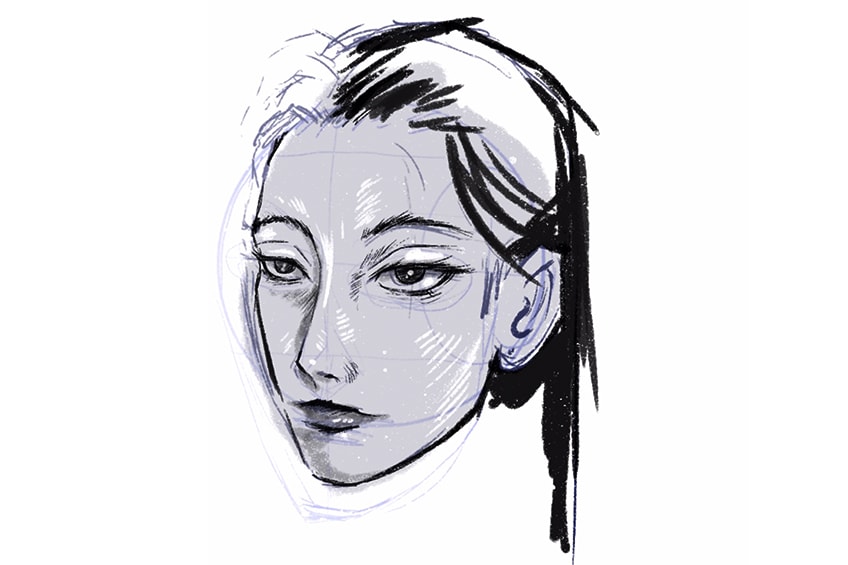
The positioning of the face in relation to the body of the character can also imply the personality and mood. Once again, the hair will always affect the aesthetic and personality of the character.
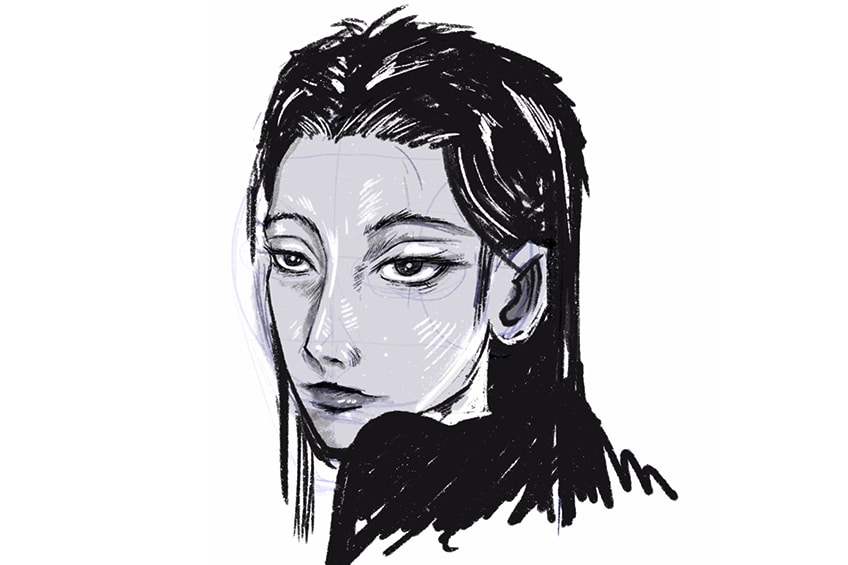
Utilizing Color for Anime Character Design
Now that we know a few tips and tricks on how to draw anime faces and heads in various ways, we can consider how color affects the overall character design.
Let’s take a look at some fundamental concepts to think through around coloring an anime character design.
Tonal Values
With anime characters, tonal value changes a lot and is generally a highly contrasting tool to help with character moods. This is a drawing representation of lighting and how it will affect the character design. In some cases, color can neutralize or emphasize aspects of the character. However, this. is where we consider the spectrum of the used colors and how the various shades are used strategically to create dimension.

For instance, in a monochromatic sense, we can use a single color’s full spectrum to define shapes and shadows along the surface area of various features.
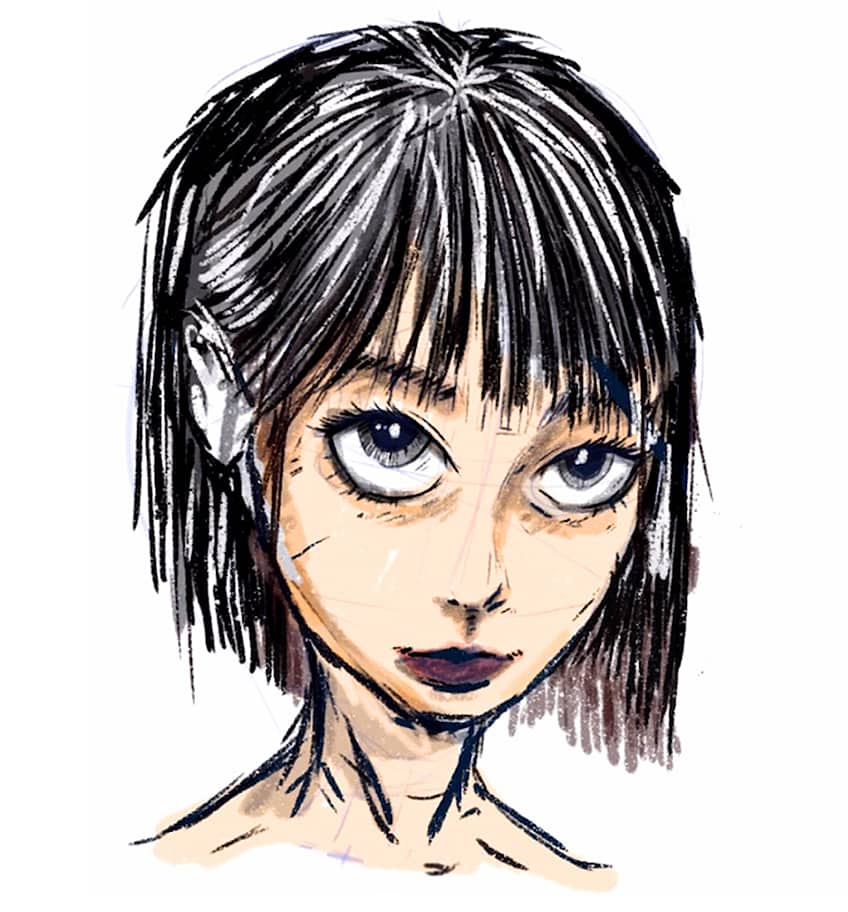
This is also an exercise in understanding the direction from which the light source is coming. This will determine the areas that are most illuminated and the areas with more shadow. This is also a good way to bring shape to the smaller details around shadows, such as the brows and how they cast a shadow over the eyes.
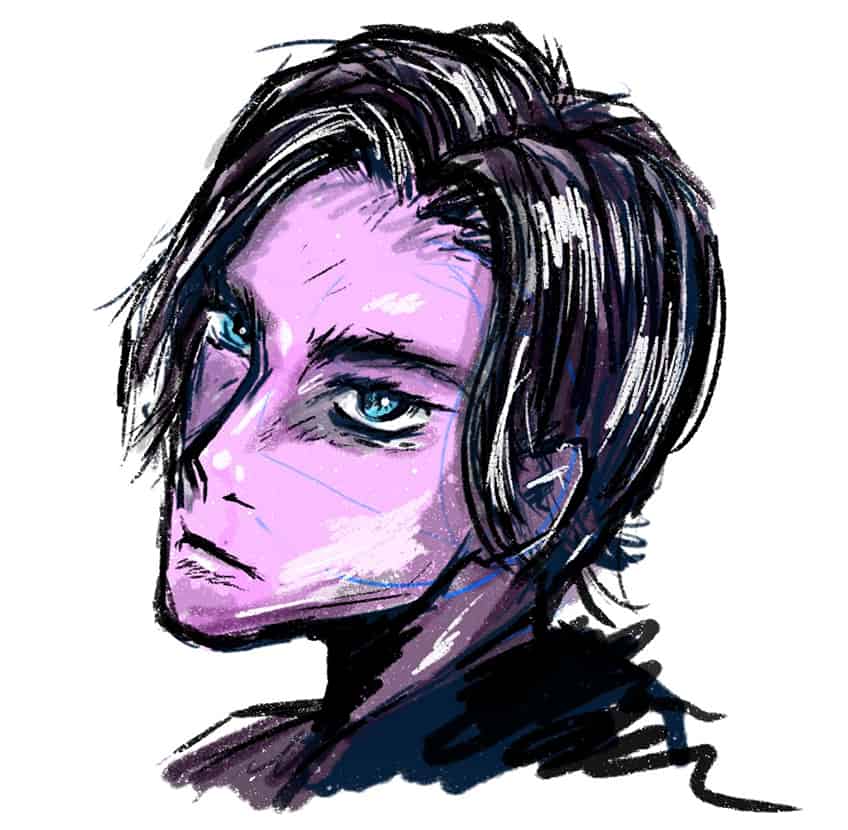
Color Choices
Already, by the simple integration of color, we find that it changes the mood, personality, and overall aesthetic of an anime character. The intention is to always consider the shape and structure of a character, how color can be used to shape the character, and the dimensions of the facial structure.

And that is how to draw anime faces and heads! A simple guide on the formation process, thinking about shape, and the unique combinations of features to define masculine and feminine qualities.
Tips and Tricks to Remember
- First, understand the placement of various facial features. Once you understand the positions of different features, you can then change them to suit the character.
- Accentuate features for more feminine qualities. Emphasizing features can define a more feminine quality.
- See hair as a contextualizing feature. Hairstyles will always define the character and help to shape their head.

There are many ways to learn how to draw anime faces. It’s a matter of style choice, which is defined by linework, details, and shape. As you learn how to draw various anime girl faces and male faces, you will see that different approaches achieve different aesthetics.
Frequently Asked Questions
How to Distinguish Anime Boy Faces from Anime Girl Faces?
There are a few ways that we can use facial features to create distinctions between male and female anime characters. For one, the anime girl head often has a more petite and triangular shape. We can incorporate this quality into male characters as well, and create a feminine quality in male anime characters. We can also consider accentuating features for more feminine aesthetics. With anime girl faces, we find that the eyes are generally enlarged, the lashes elongated, and the lips large. For male characters, the features tend to be more simplistic, square, and sharp to maintain a neutral look.
How to Draw Anime Eyes for Boy and Girl Faces?
With anime girl faces and boy faces, we always want to consider the way the eyes express the mood. Naturally, the eyes will determine the expression quite significantly, and we can start with simplistic shapes. This is where we think about squares, rectangles, circles, and other fundamental shapes that define unique expressions. In the case of more neutral expressions, we want to think about shapes that cut the eye slightly, such as rectangles and squares. For more surprised expressions, circles work well to convey that kind of emotion. Then it is a matter of refining the shaping of these simple shapes with emboldened lines to represent the lashes. With female lashes, we can elongate them with longer and bolder lines, whereas for male characters, we can keep them fairly neutral and thin.
Matthew Matthysen is an educated multidisciplinary artist and illustrator. He successfully completed his art degree at the University of Witwatersrand in South Africa, majoring in art history and contemporary drawing. The focus of his thesis was to explore the philosophical implications of the macro and micro-universe on the human experience. Matthew uses diverse media, such as written and hands-on components, to explore various approaches that are on the border between philosophy and science.
Matthew organized various exhibitions before and during his years as a student and is still passionate about doing so today. He currently works as a freelance artist and writer in various fields. He also has a permanent position at a renowned online gallery (ArtGazette) where he produces various works on commission. As a freelance artist, he creates several series and successfully sells them to galleries and collectors. He loves to use his work and skills in various fields of interest.
Matthew has been creating drawing and painting tutorials since the relaunch in 2020. Through his involvement with artincontext.org, he has been able to deepen his knowledge of various painting mediums. For example, watercolor techniques, calligraphy and lately digital drawing, which is becoming more and more popular.
Learn more about Matthew Matthysen and the Art in Context Team.
Cite this Article
Matthew, Matthysen, “How to Draw Anime Faces and Heads – An Easy Guide.” Art in Context. February 22, 2024. URL: https://artincontext.org/how-to-draw-anime-faces-and-heads/
Matthysen, M. (2024, 22 February). How to Draw Anime Faces and Heads – An Easy Guide. Art in Context. https://artincontext.org/how-to-draw-anime-faces-and-heads/
Matthysen, Matthew. “How to Draw Anime Faces and Heads – An Easy Guide.” Art in Context, February 22, 2024. https://artincontext.org/how-to-draw-anime-faces-and-heads/.



